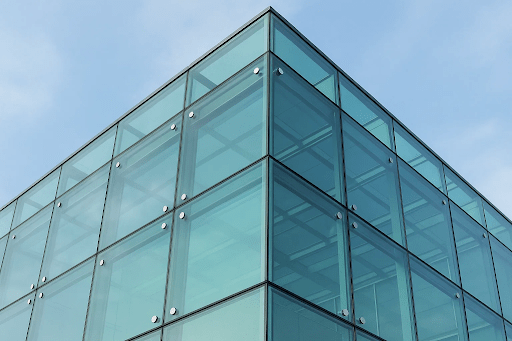Why Architects Choose Laminated Tempered Glass for Buildings

In modern architecture, form and functionality must co-exist. With the changes in the form of the building sleek facades and clear walls, safety and performance requirements are also increasing. Laminated tempered glass fits both these requirements and is actually a hybrid product becoming a favorite of architects, engineers and safety policymakers.
The article explores why the use of laminated tempered glass is being specified more and more in the new construction and remodel projects throughout the United States due to its multifunctional roles in both safety, acoustics, the structural integrity and the sustainability of the project.
Ever Wondered What Makes Laminated Tempered Glass So Tough
Laminated tempered glass is a composite resistive glass, which is made by fusing two or more tempered pieces of glass assembled together using a strong interlayer, PVB (polyvinyl butyral) or, SGP. The interlayer keeps the glass layers in place even when they break – combining the strength of tempering with the safety features of lamination.
Understanding the Dual Structure of Laminated Tempered Glass
- Tempered Glass: Heat-treated for strength—4 to 5 times stronger than standard glass.
- Laminated Layer: Interlayer bonds glass sheets together, preventing them from falling apart when broken.
Key Advantages of Laminated Tempered Glass in Construction
1. Unmatched Safety Performance
Laminated glass does not leave sharp pieces of glass. The interlayer instead fixes broken pieces together thereby minimizing the risk of injury.
Common safety applications:
- High-rise balconies and railings
- Glass canopies and overhead glazing
- Glass floors or stair treads
- Curtain walls and exterior cladding
This property makes it ideal for safety glazing compliance with U.S. building codes such as ANSI Z97.1 and CPSC 16 CFR 1201.
2. Impact Resistance
Laminated tempered glass can withstand very high impact velocity-be it hail, flying debris or ram raiding. It finds application in:
- Hurricane zones (meeting ASTM E1996/E1886 standards)
- Security glazing for schools, banks, and government buildings
- Blast-resistant glazing in critical infrastructure
3. Acoustic Control in Urban Environments
Busy cities are noisy, so architects rely on acoustic laminated glass to reduce sound transmission.
- STC (Sound Transmission Class) ratings for laminated tempered glass are typically higher than for monolithic glass.
- It is a go-to material for office buildings, hotels, recording studios, and residential towers near highways or airports.
4. UV Protection and Fade Resistance
Interlayers can absorb anything up to 99% of UV light, preventing fading of interiors and sun damage (last point is critical in museums, in storefronts and in contemporary homes with many glass-paned walls).
5. Energy Efficiency
We can use low-emissivity (Low-E) coatings, in a combination with laminated tempered units, in order to increase their thermal insulation.
- It reduces solar heat gain, helping buildings stay cooler and reducing HVAC loads.
- Eligible for LEED credits in sustainable building design.
Types of Laminated Tempered Glass Commonly Used in U.S. Projects
Understanding the types of laminated tempered glass helps architects select the right product:
| Type | Features | Applications |
| Standard PVB Laminated | UV resistance, basic safety | Doors, partitions |
| SGP Laminated | Higher structural performance | Glass facades, floors |
| Colored Laminated Glass | Tinted interlayers | Decorative glazing, branding |
| Low-Iron Laminated Glass | Crystal-clear view, low distortion | Museums, retail display |
| Smart Switchable Laminated | Switches from clear to opaque | Privacy glazing, offices |
| Fire-Rated Laminated | Fire resistance for 45–120 minutes | Stair enclosures, exits |
Why Laminated Tempered Glass Is a Preferred Choice
1. Compliance with Stringent Building Codes
U.S. building codes are evolving to favor materials that offer post-breakage retention, particularly in elevated or public spaces. Laminated tempered glass complies with:
- IBC (International Building Code)
- ASTM standards
- Local municipal regulations in states like California, Florida, and New York
2. Design Freedom Without Compromising Safety
Laminated tempered glass allows for:
- Frameless glass walls
- Minimalistic balustrades
- Transparent staircases
- Open-concept elevators
3. Durability in Harsh Climates
Laminated tempered glass withstands:
- Extreme cold (common in the northern U.S.)
- High humidity and hurricanes (Florida and Gulf Coast)
- Seismic activity (California and Pacific Northwest)
Its multi-layered design improves resistance to thermal stress, corrosion, and mechanical fatigue.
Case Studies – Where Laminated Tempered Glass Shines
1. Urban Skyscrapers
In cities like Chicago and New York, glass is an integral part of the skyline. The skyscrapers today depend on unitized curtain walls which use laminated tempered glass panels not only to resist the wind-load but also to control the noise and the heat.
2. School Safety Initiatives
In accordance with the new security requirements, several school boards around the country are swapping the normal windows with forced-entry-resistant laminated windows, especially at entryways and in classroom doors.
3. Modern Office Spaces
Switchable laminated privacy glass in meeting rooms provides the flexibility in layout with a clean open look.
4. Healthcare Facilities
Low-iron, acoustic laminated tempered glass is also used in the intensive care units (ICU), and newborn intensive care unit (NICU) of hospitals, to improve visibility as well as preventing interference caused by outside noise.
Common Misconceptions About Laminated Tempered Glass
1. “It’s too thick or heavy.”
Modern laminates come in thinner profiles and can weigh less than traditional dual-pane units. Lightweight options now support frameless glass railing systems.
2. “It’s too expensive.”
While the initial cost is higher, the lifecycle cost is lower due to:
- Fewer replacements after breakage
- Lower maintenance
- Better insulation leading to energy savings
3. “Laminated glass can’t be decorative.”
Colored interlayers, digital printing, acid-etching, and frit patterns are all compatible with laminated tempered configurations, expanding design possibilities.
What to Consider When Specifying Laminated Tempered Glass
1. Thickness & Load Requirements
Architects must account for wind loads, dead weight, and span size. Common thicknesses range from 1/4″ to 1″.
2. Edge Finishes
Polished or beveled edges improve aesthetics and safety, especially in exposed railing or stair tread applications.
3. Installation Method
It can be installed using:
- Structural glazing
- Spider fittings
- Clamp systems
- Framed systems
Each method must be evaluated based on the environment and project type.
4. Interlayer Selection
- PVB: Best for residential and interior applications.
- SGP: Ideal for exterior structural glazing or where high performance is needed.
- EVA: Offers better moisture resistance for humid climates.
Comparison of Laminated Tempered vs. Other Safety Glass Options
| Feature | Laminated Tempered | Heat-Strengthened | Monolithic Tempered |
| Post-breakage hold | Excellent | Poor | Poor |
| UV Protection | Yes | No | No |
| Acoustic Insulation | High | Low | Low |
| Impact Resistance | Superior | Moderate | Good |
| Suitable for Overhead Use | Yes | No | No |
Trends: Where Laminated Tempered Glass Is Headed in 2025 and Beyond
1. Integration with Smart Building Systems
IoT sensors embedded between laminates will allow glass panels to detect temperature, humidity, and even breakage.
2. Eco-Friendly Interlayers
Recyclable and bio-based interlayers are under research to enhance the sustainability of laminated glass products.
3. Advanced Coatings
Multifunctional coatings (e.g., anti-microbial, anti-glare, and self-cleaning) are being added to enhance performance in medical and commercial environments.
Final Thoughts
Laminated tempered glass is no longer just a high-performance alternative, but it is more of a norm of responsible and contemporary architecture. It is a strong, sustainable, stylish combination with a mix of safety for schools, skyscrapers, luxury homes, and even hospitals. Laminated tempered glass is not an option, but a requirement of architects whose goal is to put beauty in line with compliance, and innovation with utility.




